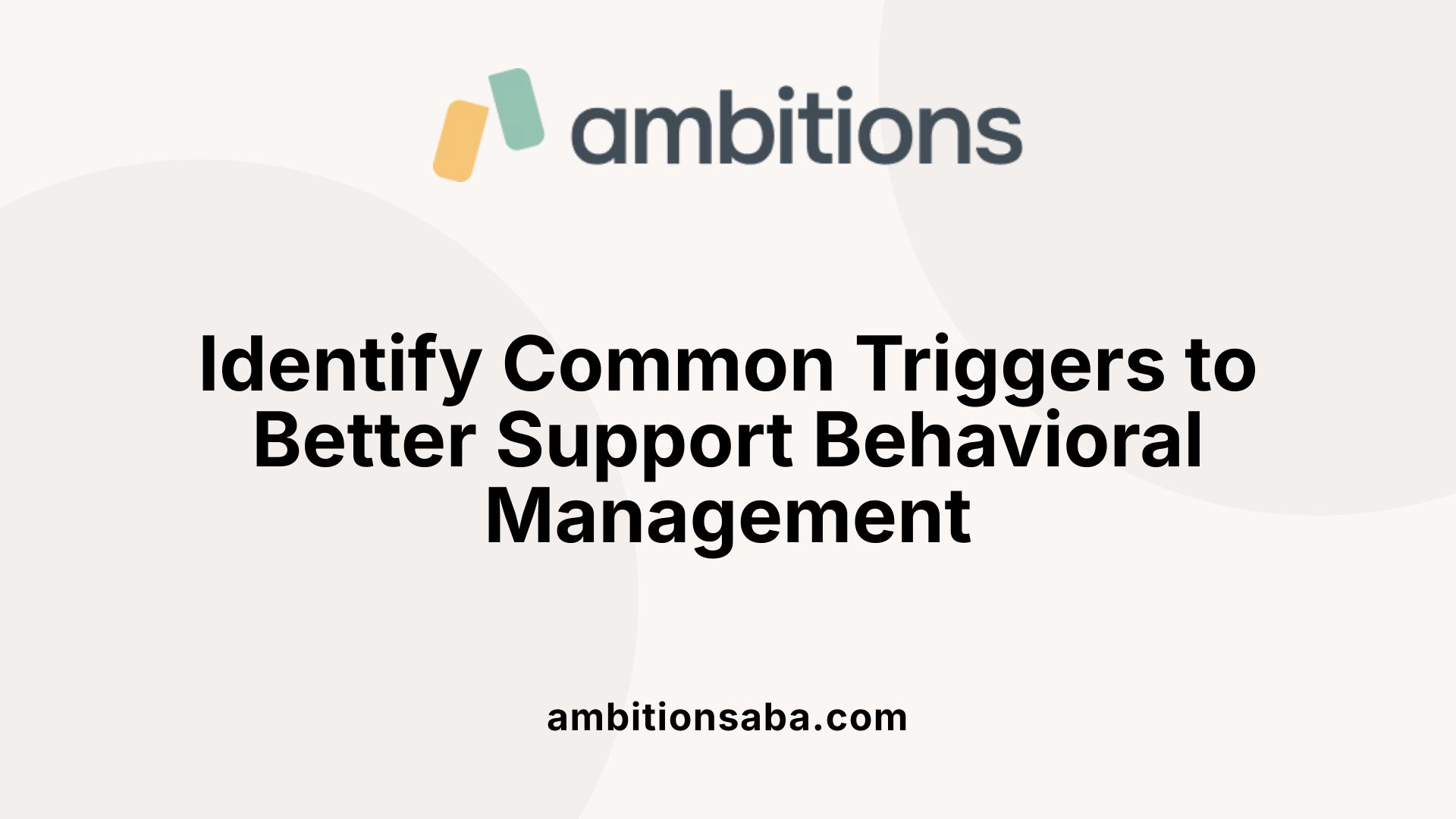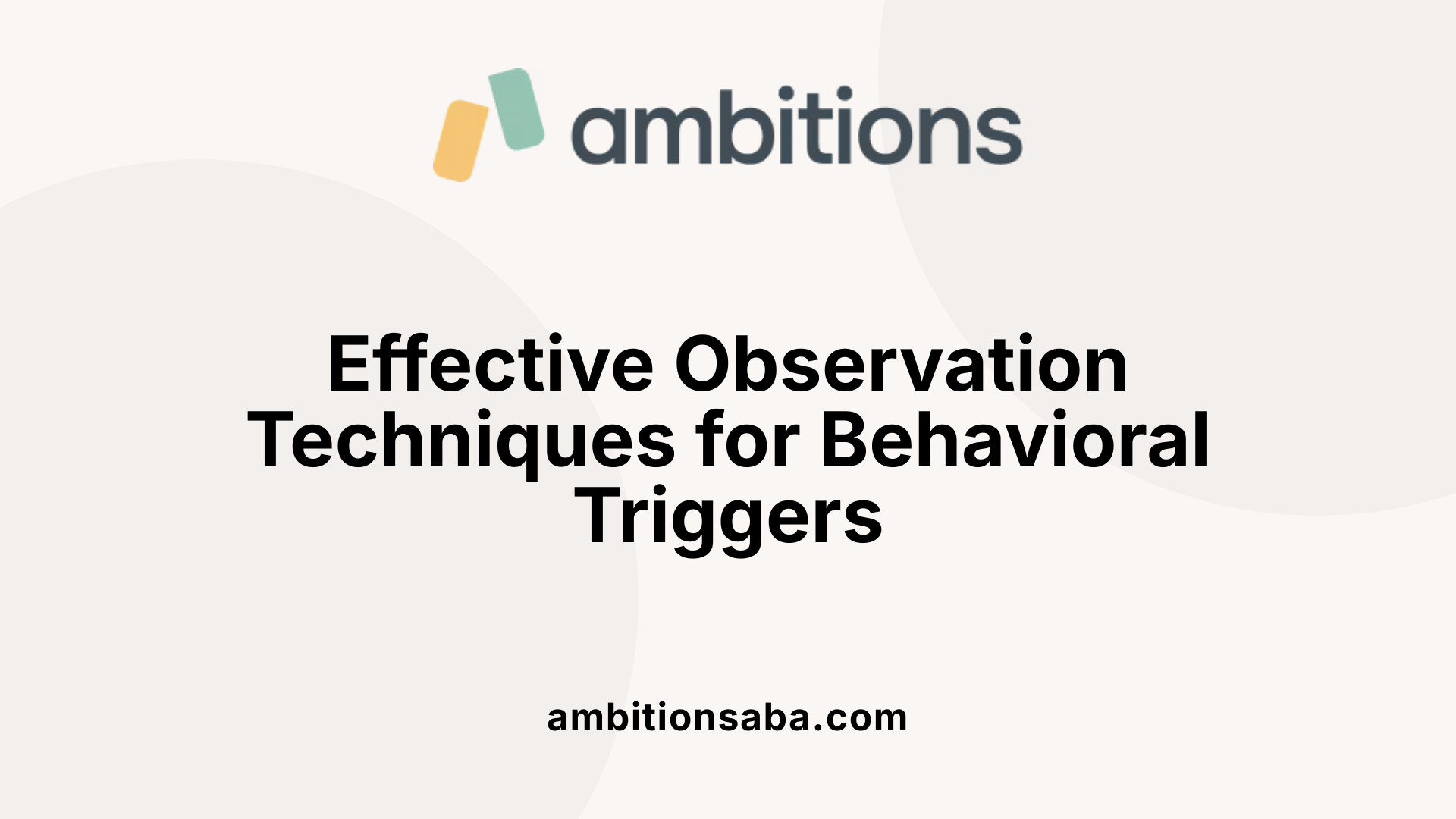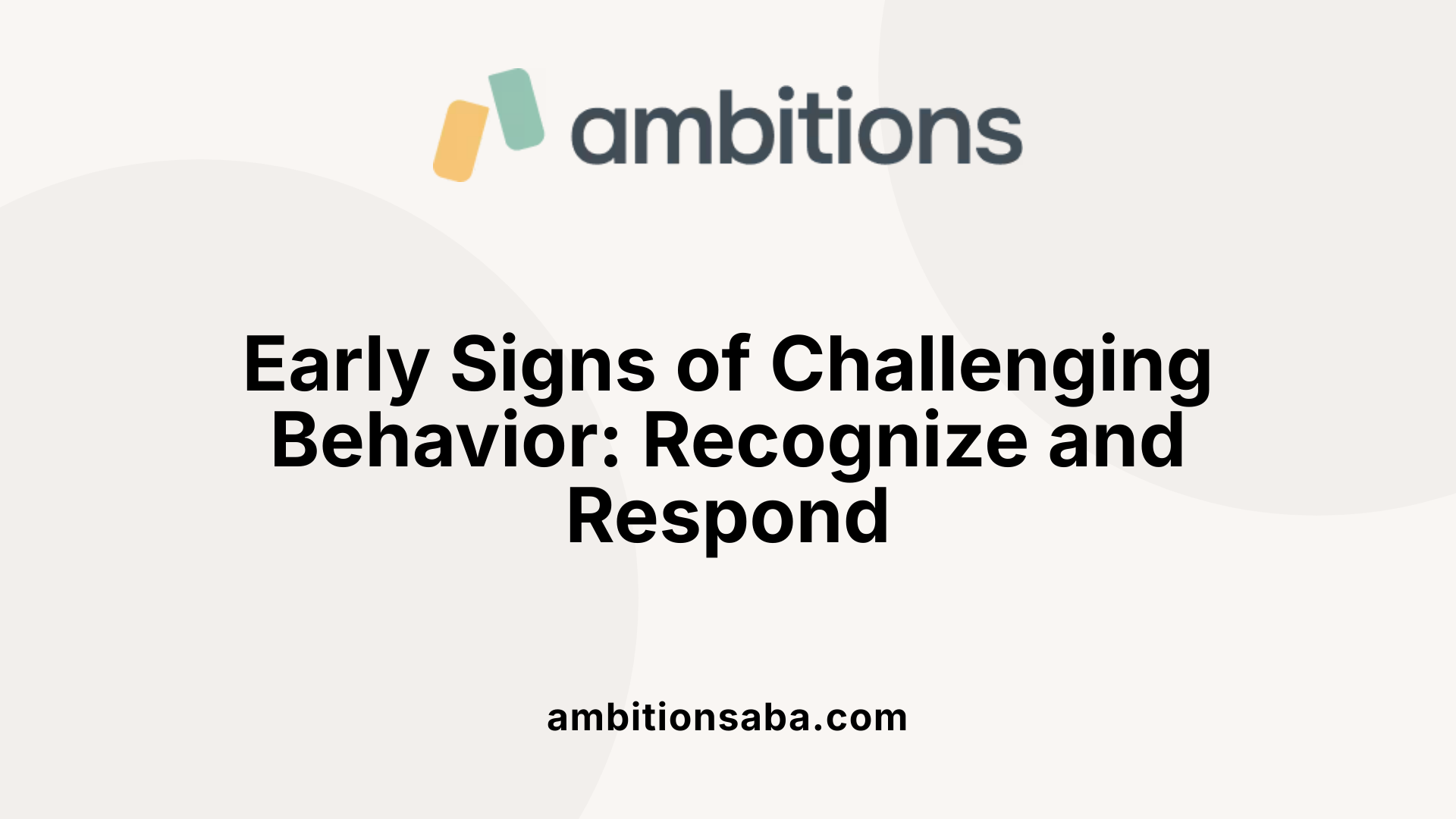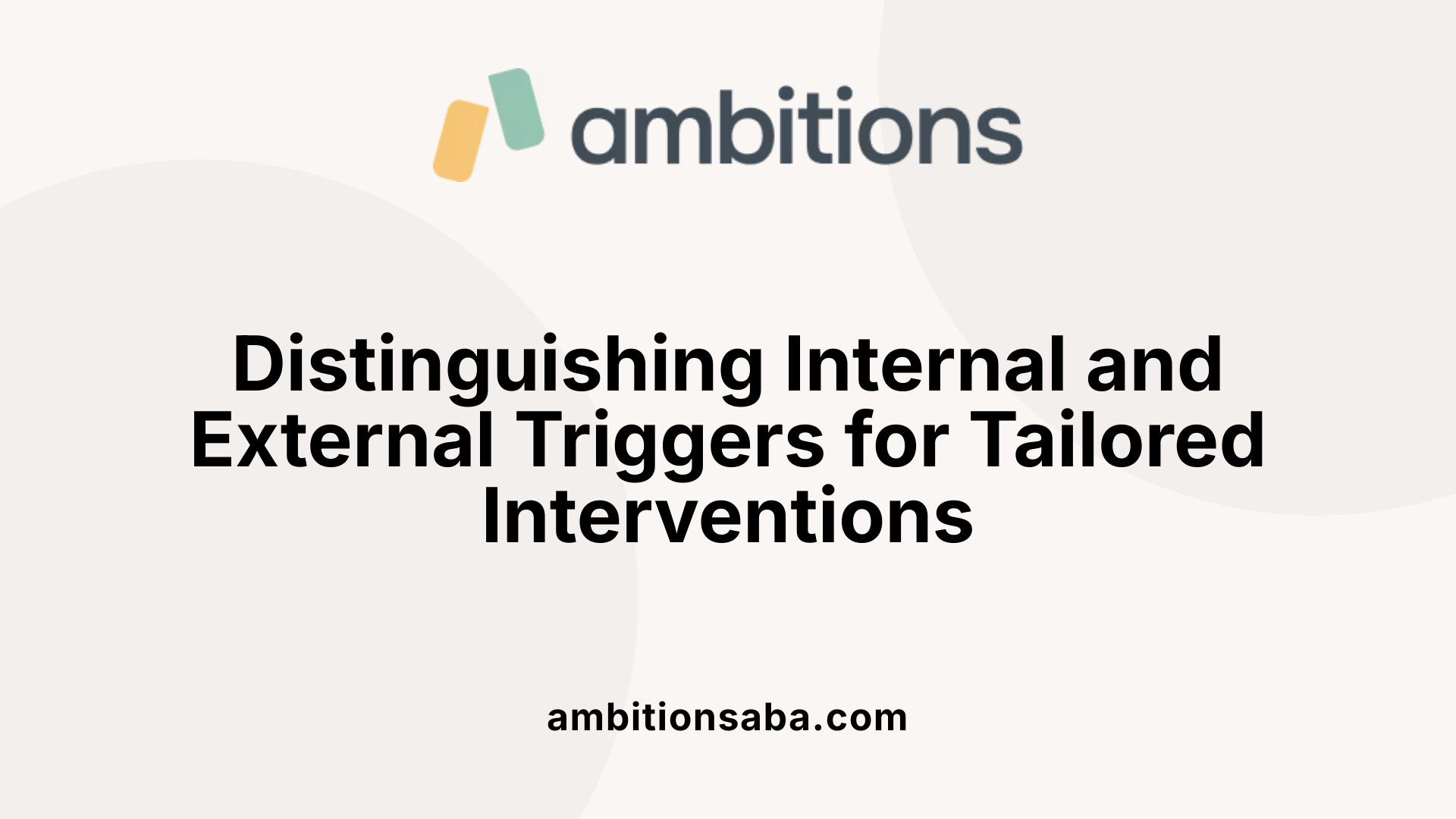Enhancing Social Understanding Through Behavioral Therapy
Opening the Door to Effective Behavior Management
Challenging behaviors in children and adults are complex actions often driven by underlying triggers. These triggers may stem from communication issues, sensory overload, physical discomfort, emotional distress, or environmental changes. Recognizing and understanding these factors are essential for caregivers, educators, and professionals aiming to implement effective interventions, improve quality of life, and foster supportive environments. This article explores key strategies to identify, analyze, and address the triggers for challenging behavior, highlighting assessment tools, behavioral frameworks, and proactive management techniques.
Common Triggers for Challenging Behavior

What are common triggers for challenging behavior?
Challenging behaviors often occur as responses to various underlying issues and external factors. Understanding these triggers is crucial for effective management and intervention.
One of the most frequent causes is communication difficulties. Individuals who struggle to express their needs or feelings may resort to disruptive or harmful behaviors as a form of communication. This is especially common in people with Autism Spectrum Disorder, learning disabilities, or speech and language challenges.
Sensory overload is another common trigger. Bright lights, loud noises, strong smells, or uncomfortable textures can overwhelm an individual’s sensory system. For someone sensitive to sensory input, this overload can lead to reactions such as aggression, self-harm, or withdrawal.
Physical discomfort or pain, such as ear infections, toothaches, constipation, injuries, or medical conditions like epilepsy, can also prompt challenging behaviors. When individuals cannot communicate their discomfort, behaviors like hitting, scratching, or biting become expressions of distress.
Emotional factors such as anxiety, stress, frustration, or anger often serve as triggers. Past trauma, depression, or ongoing mental health issues may make individuals more prone to upset and crisis behaviors.
Changes in routines or environments that disrupt predictability can cause anxiety and resistance. Individuals who rely on routine, particularly those with neurodivergent profiles, find abrupt changes overwhelming and may react negatively.
Sleep disturbances are significant triggers too. Poor sleep quality or sleep deprivation can increase irritability and reduce coping abilities, leading to challenging behaviors.
Medication side effects can also influence behavior. Certain medications might cause agitation, confusion, or fatigue, which can manifest as problematic behaviors.
Lastly, unmet needs such as hunger, thirst, hygiene, or social interaction can lead to acting out. When basic physiological or psychological needs aren’t satisfied, individuals may display behaviors like tantrums or withdrawal.
Recognizing these triggers, along with considering the purpose or function behind behaviors, helps caregivers and professionals develop targeted strategies. Observing the environmental context, emotional state, and health status provides insights into why problematic behaviors emerge and how best to support individuals in managing their needs.
How to Observe and Note Behavioral Triggers

behavioral observation techniques
Effective observation begins with attentive monitoring of individuals to understand what precedes challenging behaviors. This process involves systematically noting any changes in behavior in response to environmental stimuli or internal states. Careful observation helps identify patterns that may not be immediately obvious, such as subtle signs of distress or increasing frustration.
noting context and environment
It is crucial to record the context in which behaviors occur. Pay attention to where, when, and with whom the behavior happens. Documenting environmental factors such as noise levels, lighting, or the presence of other people provides insight into external triggers.
timing of incidents
Note the timing of events leading up to and following challenging behaviors. This includes the time of day, duration between events, and the sequence of actions. Recognizing that behaviors often follow certain routines or specific situations helps in pinpointing trigger points.
tracking antecedents and consequences
Using tools like the ABC (Antecedent, Behavior, Consequence) chart is an effective way to document behaviors. Record what happens immediately before the behavior (antecedent), the behavior itself, and what occurs afterward (consequence). This pattern can reveal whether the behavior is a response to specific triggers or environmental conditions.
use of ABC charts
An ABC chart is a structured method for capturing detailed information about challenging behaviors. It typically includes columns for date and time, antecedents, the specific behavior, and consequences. Filling out this chart consistently over several weeks helps identify recurring triggers, understand the function behind behaviors, and develop targeted strategies for intervention.
How can I identify triggers for challenging behavior in children and adults?
To effectively uncover triggers, observe reactions carefully and note when, where, and with whom behaviors occur. Pay attention to environmental stimuli like sights, sounds, or smells, as well as internal feelings such as anxiety or frustration. Keep track of patterns over time through detailed records, noting the context and responses to identify specific triggers. Employ coping strategies like setting boundaries, offering support, and using trigger warnings to help manage responses and prevent escalations.
Recognizing Signs that Signal an Impending Challenging Behavior

How can I recognize signs that precede challenging behavior?
Identifying early warnings of challenging behaviors is crucial in managing and preventing escalation. Observing subtle cues in facial expressions, body language, and verbal communication can reveal when an individual is becoming agitated or distressed.
In the initial phases—often marked by triggers, agitation, and acceleration—individuals may display signs like clenched fists, fidgeting, pacing, or avoiding eye contact. These behaviors are often subtle but serve as important signals that someone is on the verge of acting out.
Verbal cues also play a significant role. A person might start to speak more rapidly, use louder tones, or begin to complain or whine, indicating rising frustration. Recognizing these cues early gives caregivers chances to intervene with calming strategies.
Utilizing structured tools like the ABC (Antecedent, Behavior, Consequence) chart or the CRISIS framework can help identify recurring patterns and triggers. For example, a specific routine change or sensory overload may often precede challenging behaviors.
Understanding that many challenging behaviors are a form of communication—expressing unmet needs, discomfort, or stress—can foster empathetic responses. Responding promptly to these early signals often prevents behaviors from escalating into more disruptive or harmful actions.
In sum, maintaining vigilance for subtle facial and body cues, listening for verbal hints, and understanding behavioral escalation indicators—especially through systematic monitoring—are essential. Early recognition allows for timely intervention, helping to support individuals effectively and compassionately.
Understanding Internal and External Triggers

What is the difference between internal and external triggers?
Understanding the distinction between internal and external triggers is vital to managing challenging behaviors and emotional responses.
Internal triggers refer to internal states such as thoughts, feelings, sensations, or memories that arise within the person. These can include emotions like anxiety, sadness, or excitement, as well as physical sensations such as pain or fatigue. For example, a person might feel overwhelmed by a surge of anger or sadness, which then prompts certain behaviors.
In contrast, external triggers are stimuli from outside the individual’s body or environment. These include aspects like noisy settings, sudden changes in routine, interactions with specific people, or certain sensory inputs like bright lights or loud sounds. For instance, a child might react negatively when asked to change activities abruptly or be in a crowded space.
Managing these triggers requires different approaches. For internal triggers, developing emotional regulation skills like mindfulness, deep breathing, and cognitive-behavioral techniques can help individuals process and cope with their internal states effectively. These strategies help in recognizing early signs of emotional escalation and prevent behaviors from intensifying.
To address external triggers, it often involves modifying the environment or routine. This can mean avoiding crowded places during certain times, creating predictable schedules, or providing sensory-friendly spaces. Adjustments in routines and environments can significantly reduce the likelihood of triggering challenging behaviors.
Recognizing the precise nature of triggers allows caregivers, educators, and individuals to implement targeted strategies. For example, if a person's emotional outbursts are primarily linked to internal feelings of anxiety, therapy and self-awareness practices may be most effective. Conversely, if external stimuli like loud noises are the main triggers, environmental modifications are more appropriate.
In summary, internal triggers originate within the individual, influencing their emotional and physical state, while external triggers stem from the surrounding environment and social context. Both require tailored strategies to foster better emotional health and reduce challenging behaviors.
Analyzing Behavioral Patterns with Frameworks
How can behavioral patterns be analyzed to identify triggers?
Understanding and managing challenging behaviors begins with analyzing behavioral patterns. This process involves systematically observing and recording antecedents (what happens before the behavior), behaviors, and consequences — collectively known as the ABC model. Gathering this information helps identify specific triggers that provoke certain reactions.
To conduct a thorough analysis, practitioners often use tools like ABC charts, which record details such as the time, location, people involved, and what the individual was doing just before the behavior. By reviewing these recordings over multiple instances, patterns often emerge. For example, a child may frequently act out after transitions or in noisy environments.
In addition to ABC charts, frameworks like the CRISIS model are used to assess main issues triggering behaviors. This model encourages considering areas such as communication difficulties, routines, interactions, sensory sensitivities, imagination, and personal subjectivity. Detecting common themes or recurring situations across data points allows caregivers and therapists to pinpoint particular triggers.
Functional assessment techniques are vital for this process. These may include interviews with caregivers, self-monitoring by the individual where possible, or behavioral observations. They help determine the purpose of behavior — whether it is aimed at gaining attention, escaping an unpleasant situation, seeking sensory input, or fulfilling unmet needs.
Tracking these patterns over time offers insight into how triggers relate to specific behaviors. For instance, analyzing data might reveal that a child often becomes aggressive when hungry or tired. Recognizing these trends enables targeted intervention strategies, such as adjusting routines or environment, teaching coping skills, or providing sensory supports.
Effective trend analysis fosters greater self-awareness for individuals and offers caregivers concrete data to modify their responses or environments. This data-driven approach improves the likelihood of preventing challenging behaviors and creating supportive, nurturing settings.
Ultimately, analyzing behavioral patterns with structured frameworks and detailed record-keeping paves the way for tailored, effective behavior management plans that address the root causes of challenging actions.
Strategies for Preventing and Managing Triggers

What strategies can help prevent and manage triggers for challenging behaviors?
Preventing and managing triggers effectively involves employing a range of proactive strategies tailored to individual needs. One fundamental approach is establishing predictable routines. Consistent daily schedules help reduce uncertainty, which can be a major source of anxiety and triggers for challenging behaviors.
Using visual supports such as picture schedules, social stories, or cue cards helps clarify expectations and upcoming activities. Visual aids are especially helpful for individuals with communication difficulties, providing concrete cues that improve understanding and reduce frustration.
Preparing individuals for transitions with pre-transition warnings, countdowns, or visual timers allows them time to adapt, decreasing the likelihood of distress and subsequent challenging behaviors. For example, announcing a change five minutes in advance or showing a visual countdown can ease anxiety associated with abrupt changes.
Implementing positive reinforcement is vital. Recognizing and praising desired behaviors encourages their repetition. Offering choices empowers individuals, fostering a sense of control and reducing oppositional or disruptive behaviors.
Environmental modifications also play a crucial role. Reducing sensory overload by managing lighting, noise levels, and textures can significantly lessen triggers. Creating calm, safe spaces where individuals can retreat when overwhelmed provides an essential support mechanism.
Developing individualized care plans that consider each person’s unique triggers and needs is essential. These plans often include specific strategies for managing known triggers and promoting positive behaviors.
Staff training is equally important. Caregivers and teachers equipped with knowledge of trigger identification and intervention techniques are better prepared to respond calmly and effectively. Ongoing professional development ensures that staff stays updated on best practices.
Finally, collaboration with families facilitates a comprehensive understanding of triggers and consistency in approaches across settings. Regular reflection on what triggers behaviors and adjusting strategies accordingly help maintain an adaptive and supportive environment.
By integrating these strategies—creating a structured environment, using supports, preparing individuals for change, and training staff—care providers can substantially reduce the frequency and intensity of challenging behaviors, promoting safer and more positive experiences.
Understanding the Function of Behaviors for Effective Intervention
How can understanding the purpose or function of challenging behaviors assist in management?
Recognizing why a challenging behavior occurs is crucial in developing effective management strategies. Every behavior has a purpose or function, often rooted in unmet needs or communication attempts. By understanding whether a behavior is seeking attention, avoiding a difficult task, seeking sensory stimulation, or trying to access a tangible object, caregivers and educators can tailor their responses more precisely.
For instance, if a child repeatedly hits others to gain attention, interventions might focus on teaching alternative, appropriate ways for the child to seek attention, such as using words or gestures. If the behavior serves an escape function, such as avoiding a challenging activity, providing modified tasks or alternative ways to communicate discomfort helps address the root cause.
Developing a clear understanding of the behavior's function guides the creation of targeted behavior support plans. These plans often include techniques like differential reinforcement, where desirable behaviors are reinforced while challenging ones are not reinforced or are replaced with more appropriate responses. Teaching alternative skills, such as communication methods or calming techniques, also helps reduce the occurrence of the problematic behavior.
Functional Behavior Assessments (FBAs) are key tools used to identify the function of behaviors by observing patterns and collecting data. Once the function is understood, interventions can be individualized and proactive, emphasizing prevention and skill-building rather than punishment.
This approach not only manages behaviors more successfully but also supports the emotional and developmental needs of individuals. Encouraging understanding and empathy while focusing on the purpose of behaviors helps create a supportive environment where individuals can learn new, positive ways to communicate and meet their needs effectively.
Utilizing Assessment Tools and Scales
Are there assessment tools or scales to help identify triggers?
Yes, a variety of assessment tools and scales exist to help identify triggers behind challenging behaviors. One prominent example is the CATS (Comprehensive Assessment of Triggers for Behaviors of Concern Scale). Developed through rigorous research and involving interviews with caregivers, CATS includes 333 triggers categorized into five main domains: external environment, internal factors, expression of volition, characteristics of intellectual disabilities, and specific activities or events. This comprehensive approach allows caregivers to pinpoint contextual triggers across diverse situations, aiding in tailored intervention planning.
In addition to CATS, functional behavioral assessments (FBAs) are widely used. These involve detailed observations of behaviors over time, focusing on antecedents and consequences to understand the purpose or function of the behavior. The ABC (Antecedent-Behavior-Consequence) data collection tool is fundamental in this process. It records the circumstances immediately before and after the behavior, providing valuable insights into patterns, triggers, and reinforcement mechanisms.
Psychometric assessments also play a role in identifying emotional triggers. Tools like the STAXI-2 (State-Trait Anger Expression Inventory-2) measure levels of anger and hostility, helping identify triggers related to emotional responses. Furthermore, inventories designed to assess aggression or anxiety can uncover psychological factors that provoke challenging behavior.
Implementing these tools involves collecting data through observations, interviews, and sometimes self-reporting, depending on the individual’s needs. Interpreting findings requires an understanding of behavioral patterns, environmental influences, and emotional states. When triggers are identified, strategies can be tailored to prevent escalation, such as environmental modifications or emotional regulation techniques.
Overall, combining structured scales like CATS with observational tools and psychometric assessments offers a holistic view of triggers, enabling more effective and personalized behavior support approaches.
Educating Caregivers and Professionals about Behavior Triggers and Management
How should caregivers and professionals be educated about triggers and behavior management?
Effective education for caregivers and professionals is fundamental to managing challenging behaviors, especially for individuals with communication difficulties, sensory sensitivities, or trauma backgrounds. Training programs should be comprehensive, covering the identification of common triggers such as environmental stressors, physical discomfort, or cognitive overload.
Practical, evidence-based strategies are core components of effective training. Techniques include de-escalation methods to calmly address rising tension, trauma-informed care approaches that recognize the impact of past trauma, and communication tools like visual supports or simplified language to enhance understanding.
Equipping caregivers with specific tools can make a significant difference. For example, maintaining consistent routines and providing clear visual cues or memory aids help prevent triggers like confusion or frustration. Incorporating sensory techniques, such as creating quiet spaces or using calming textures and sounds, can mitigate sensory overload.
Ongoing professional development is necessary to stay updated on best practices. Accessible training sessions, workshops, online resources, and support networks foster caregiver confidence and promote consistency in responses.
Collaborative efforts with healthcare professionals, therapists, and educators further strengthen behavioral management plans. Importantly, incorporating caregiver wellness—like stress management and self-care—ensures they can sustain compassionate, effective support.
In summary, a holistic training approach that combines theoretical knowledge, practical skills, ongoing education, and community collaboration is essential for empowering caregivers and professionals in managing triggers and promoting positive behaviors.
Harnessing Knowledge to Create Supportive Environments
Understanding and recognizing triggers for challenging behavior is fundamental to developing effective management strategies. By observing behaviors, analyzing patterns, and utilizing assessment tools, caregivers and professionals can decipher the underlying causes of challenging actions. Employing proactive interventions such as routine planning, environmental modifications, and targeted support can significantly reduce the occurrence of such behaviors. Equally important is fostering empathetic, trauma-informed approaches and continuous education for caregivers and staff. Through these combined efforts, we can create safer, more supportive environments that respect individual needs, minimize distress, and promote positive growth and development for children and adults alike.
References
- What Can Trigger Behaviours That Challenge and How to Prevent it?
- [PDF] Identifying Triggers of Challenging Behaviour from an ABC Chart
- Page 4: Trigger - IRIS Center
- Identifying your child's behavior triggers - Understood.org
- [PDF] Navigating Through Challenging Behaviors - DSHS
- [PDF] Finding the Reasons for Challenging Behaviour: Part 2
- Complete Guide to Managing Behavior Problems - Child Mind Institute
- Behaviours That Challenge: Triggers and Prevention
- Understanding the Cycle of Challenging Behaviour

